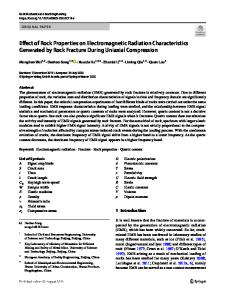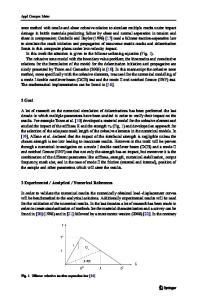Numerical simulation on effect of heterogeneity on mode I fracture characteristics of rock
- PDF / 3,435,444 Bytes
- 15 Pages / 595.22 x 842 pts (A4) Page_size
- 41 Downloads / 280 Views
Numerical simulation on effect of heterogeneity on mode Ι fracture characteristics of rock WANG Jin-tao(王金涛)1, ZUO Jian-ping(左建平)1,
2
1. School of Mechanics and Civil Engineering, China University of Mining and Technology-Beijing, Beijing 100083, China; 2. State Key Laboratory of Coal Resources and Safe Mining, China University of Mining and Technology-Beijing, Beijing 100083, China © Central South University Press and Springer-Verlag GmbH Germany, part of Springer Nature 2020 Abstract: Rock is more sensitive to tensile loading than compressive loading, since the tensile strength of rock is much lower than compressive strength. The fracture characteristics of rock in the tensile state are of great significance to the understanding of rock failure mechanisms. To this end, we have conducted numerical simulation researches on mode Ⅰ cracking process of rock with varying homogeneity, using the Realistic Failure Process Analysis program. With the increase of homogeneity, cracks are concentrating to the ligament area with a decreasing number of crack bifurcations, and the main crack path is becoming smooth. Crack behaviors and mechanical properties are influenced significantly when the homogeneity index is in the range of 1.5 to 5. When the homogeneity index is greater than 30, they are not affected by rock homogeneity and the rock can be considered as essentially homogeneous. It is considered that the global and local strengths are affected by the distribution of rock mechanical properties at mesoscale, which influence the crack behaviors and mechanical characteristics. Key words: rock heterogeneity; crack evolution; subcritical crack growth; fracture mechanism Cite this article as: WANG Jin-tao, ZUO Jian-ping. Numerical simulation on effect of heterogeneity on Mode I fracture characteristics of rock [J]. Journal of Central South University, 2020, 27(10): 3063−3077. DOI: https://doi.org/ 10.1007/s11771-020-4529-1.
1 Introduction Heterogeneity is an intrinsic property of rock, which is reflected in mineral components and microstructures. For the same rock, the physical and mechanical properties of mineral grains, as well as cementing materials, are considerably different. The size and the spatial distribution of mineral grains and rock pores (cracks) are highly discrete. Intact rock is usually regarded as homogeneous and isotropic materials, and on this basis, its energy
evolution [1], deformation characteristics [2], strength criterion [3, 4], etc. are analyzed. However, it has been verified by experiments that effects of heterogeneity on rock deformation and failure mechanism cannot be ignored at mesoscale [5−10] and heterogeneity is considered as the primary cause for mechanical nonlinearity at macro-scale [11]. Numerical simulation is a preferred way to investigate the effects of heterogeneity, by conducting loading tests on heterogeneous numerical models. Most of existing numerical researches focus on the effects of heterogeneity on
Foundation item: Project(BJJWZYJH01201911413037) supported by the Beijing Outstan
Data Loading...











